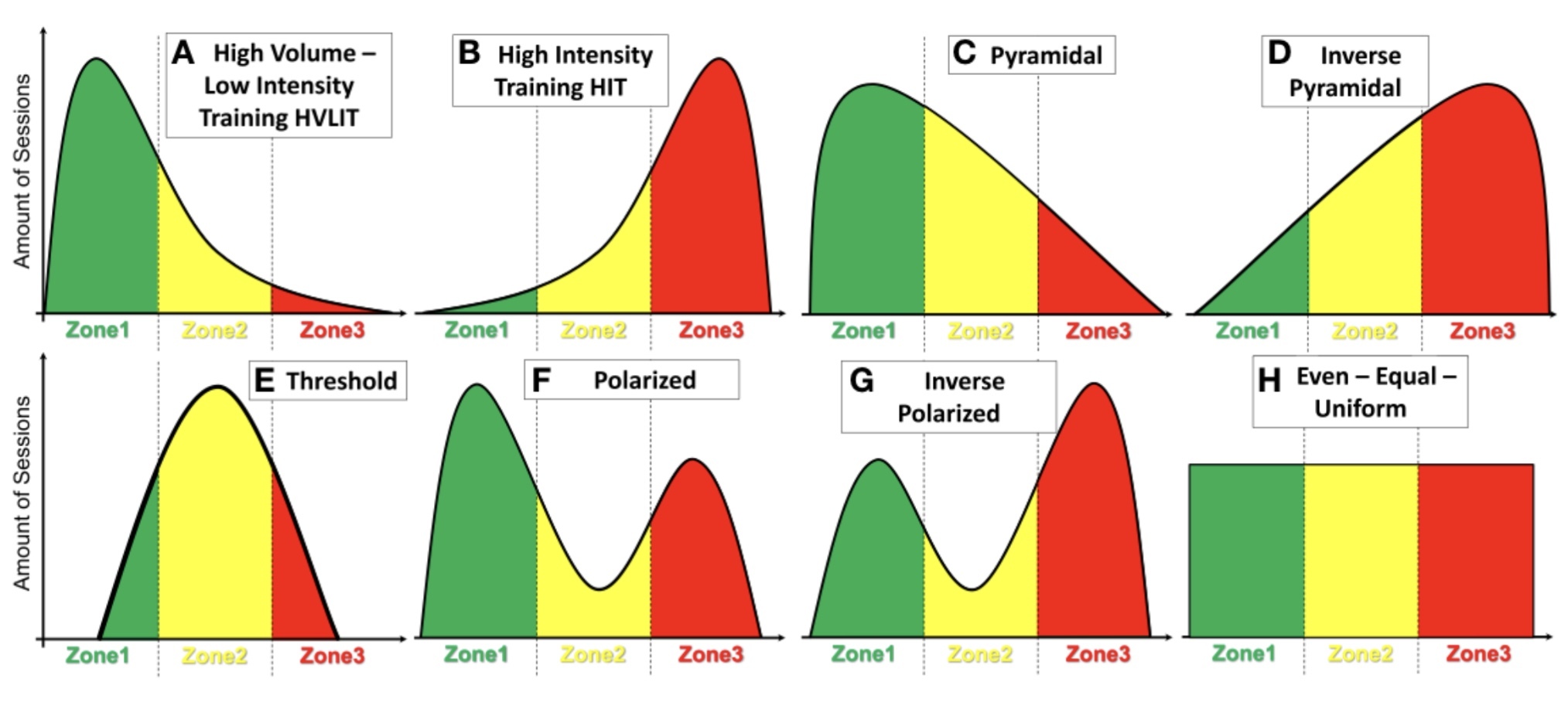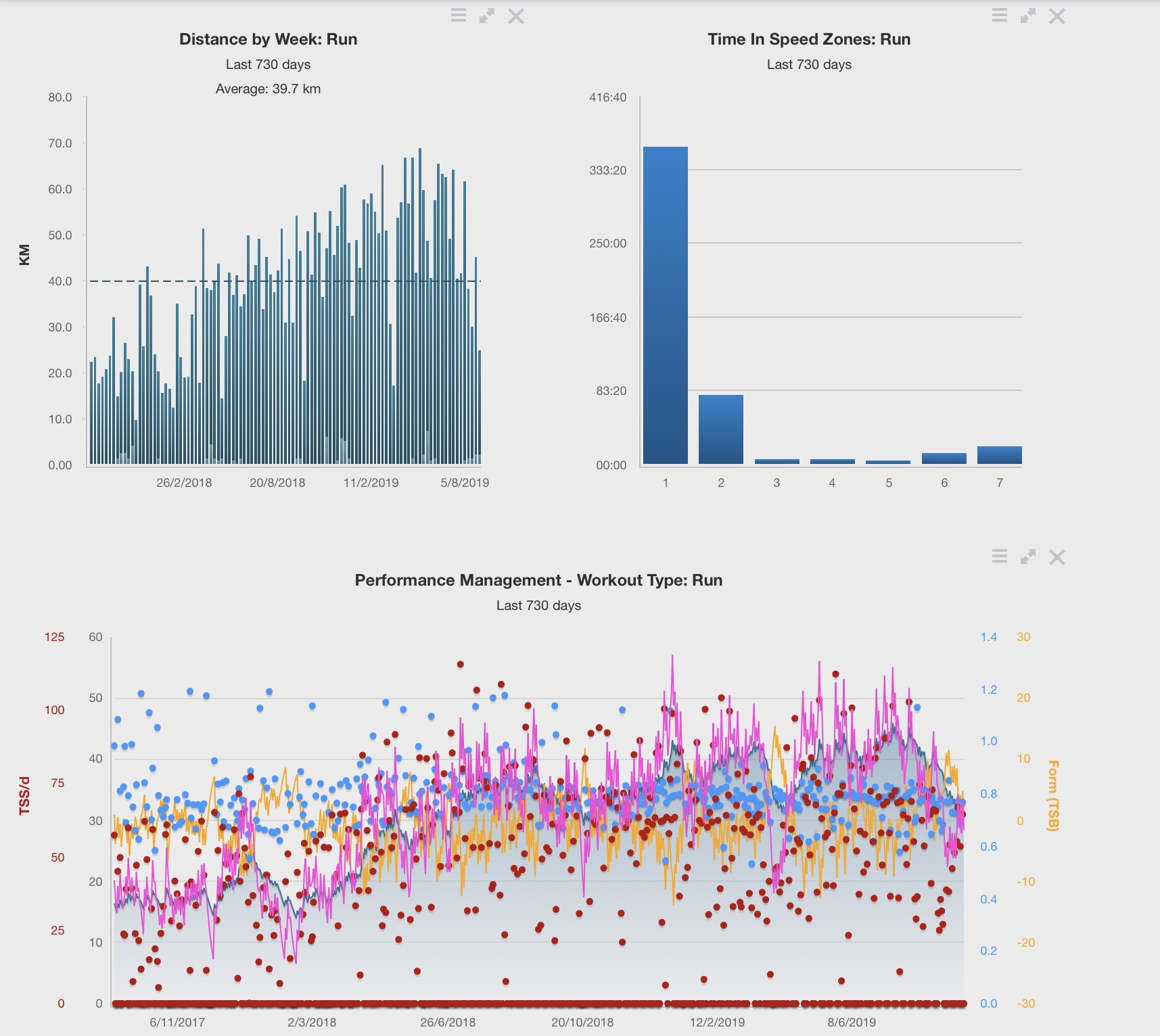Hierarchy of sustainable running – Part 2 Training Characteristics, organisation and progression.
Posted on September 23, 2019It’s well accepted that sustainable running training begins with selecting a training regime that is suited to the runners relative training state at that point in time. With training errors arguably the most important factor in Running Related Injuries (RRI) (Hrejlac, 2005), it makes sense to avoid those errors. However, we need to know what these errors are in an attempt to avoid them! Running coaches have spent many years intuitively or objectively manipulating runners training characteristics to improve a runner’s performance while attempting to reduce the risk of a training error that may lead to injury or overtraining.
Which Characteristic(s) cause injury?
Running training characteristics are best described via running; frequency (sessions/weeks), running volume (can be described as distance [km] or duration [hours:minutes]) and intensity (effort). So, which one of these training characteristics is responsible for RRI? Imagine if it was that easy? Only a single variable that is the major risk factor to RRI? Unfortunately, it’s far from that simple. A systematic review of 30 studies found it was not possible to determine which specific training characteristic was associated with RRI, as these variables have complex interactions with each other which most studies have been unable to dissociate (Nielsen et al., 2012).
Evidence from clinical and experimental studies show training characteristics such as rapid increases in volume may be linked to the development of common knee RRI, while rapid increases in pace may be associated with lower-leg RRI (calf, foot or Achilles injury). This suggests that rapid increases in particular training characteristics may increase risk at different anatomical sites (Nielsen, 2013). Indeed, it could be argued that the interaction of multiple training characteristics are required to increase risk of RRI, for example, a weekly 30 minute running session that has a focus on speed/intensity may not exceed a tissues capacity that leads to RRI, however two speed sessions within 48 hours (increased frequency), or one 60 minute speed session (increased duration) may increase the risk for that runner.
Manipulation of Training Habits to keep loading:
The manipulation of training characteristics is not only important to improve your running ability, but they are also important to reduce or manage injury/pain. A runner who is struggling with a pain related to a spike in training characteristic, a clever running coach/practitioner may be able to keep you running by a temporarily manipulation of your running habits. For example, a runner that may have increased the running volume quickly and the large accumulative load leads to experiencing knee pain (iliotibial band syndrome or patella-femoral pain syndrome) a training tweak could include replacing volume with more intense, but shorter training sessions. This may reduce accumulative loads, but increase short term peak loading that may shift loading from the knee to the lower-leg temporarily. This could work in reverse also, if a runner is suffering from ongoing calf issues, the relative intensity (running pace) could be reduced and/or replaced with lower paced running, but collecting more duration temporarily. Even those niggling Achilles’ tendon injuries that many runner’s take time off for, could attempt to maintain running loads but reduce the frequency of sessions/week to allow for tendon adaptation. Those that continue to train with lower-leg tendon issues who incorporate high speed sessions (increase tendon energy storage activities) could reduce the frequency of those sessions temporarily, or replace with easier runs while building their tissue tolerance (weight training) away from running. These habits may promote strength, still allow positive adaptations and reduce risks associated with de-conditioning.
Sustainable training organisation:
While the literature has not cleared up the ‘best way’ to train to improve and stay injury free yet, over the past 2 decades, retrospective studies have investigated how the best endurance athletes organise their training. We know that top endurance runners train a lot (lots of volume for many years on end), which usually means they’ve selected a model that is consistent and sustainable.
Endurance running requires organising of duration, frequency and intensity of training sessions in an attempt to chase improvements. A recent interest has evolved in the literature discussing how the best distribute their intensity throughout a training cycle (training intensity distribution [TID]). For simplicity, intensity in running can be measured with multiple methods (heart rate, pace or rate of perceived exertion) and described as 3 intensity zones: Low intensity (LIT - jogging, aerobic running), High intensity (HIT - repetitions, intervals or sprinting) & threshold intensity (ThT - between low and high intensity).
It was the work from Dr Stephen Seiler that began to spark interest in this area when his data showed that the best endurance runners tended to selected a Polarised (POL) TID (80% low intensity and 15-20% high intensity and the rest ThT intensity) (Seiler 2006). Further research has confirmed this, and suggested other top endurance athletes select a similar TID known as a pyramidal model (LIT > ThT > HIT) (Stoggl & Sperlich 2015). Specifically for top class runners, Keneally et al (2017) performed a systematic review that showed Pyramidal and Polarised TID were more effective in relation to increasing performance than a Threshold TID. Both these models have a large amount of LIT, suggesting perhaps it’s a requirement to be a higher performer?
 Training Intensity Distribution variations (Stoggle 2018)
Training Intensity Distribution variations (Stoggle 2018)
Top class runners still complete many ThT or HIT sessions in order to improve, yet due to the large duration of training time required to be at the top, it is really no surprise that plenty of low intensity training is required. It may add to their sustainability. However, someone who runs less frequent could surely could benefit from a higher ratio of HIT or ThT sessions though? Munoz et al (2013) found recreational runners actually improve more following a POL TID than ThT TID, this was also noted amongst recreational trail runners (Perez et al 2018). While there is limited research in this area on the training characteristics of recreational runners, anecdotally we tend to see many runners run ‘not too easy, not too hard’, suggesting a threshold TID. Whether this is a risk factor for injury, this is yet to be established, but it very interesting and should be considered clinically.
Training Progressions:
So how much training increase is too much increase? While it is common sense that too much too soon is associated with injury risk, we do not have a clear answer. The 10% rule has been quoted often, yet literature hasn’t shown this to be more protective than other increases (Buist et al 2008). Other research has showed that over 30% increases of weekly volume may have higher associations to RRI risk than say 20% (Nielsen et al, ). Obviously, common sense would suggest that continual increases of volume of 10% or 20% are not sustainable forever, and they are not necessarily required to continually improve.
There is NO ABSOLUTE value of weekly increase that has been shown to be a silver bullet to answer this question. The amount of dose you can increase form week to week varies between populations due to so many complex variables. Your training frequency, duration, distance and intensity all have complex interactions that lead to external and internal stimulus that require varied adaptation time (to be covered in the next blog)! Monitoring training load needs to take into account non modifiable risk factors (experience, age and previous injury) and modifiable risk factors (BMI, biomechanics, tissue tolerance) in order to allow a runner to find their balance between attracting performance adaptations and perhaps keep their injury risk lower (Hume et al, 2015)! Sometimes we react to the same mileage differently due to not accounting for the other training characteristic that may alter (intensity) or because of higher internal stresses (not to do with running) that may delay adaption. So how much increase is too much too soon that can be relied on sustainably, 10%, 20%, 30%, well....It's much more complicated. Solving the puzzle is currently as much intuitive as it is science, as a recent systematic review revealed our evidence for 'too much too soon' is clearly not there yet (Damsted et al 2018).
 Measuring Load: Top left - Training distance progression, Top Right - TID (pace), Bottom (Training Stress Graph) - all over 2 years
Measuring Load: Top left - Training distance progression, Top Right - TID (pace), Bottom (Training Stress Graph) - all over 2 years
Spending time assessing and organising the training characteristics of a runner remains arguably the most important piece of the performance increase and injury reduction puzzle. A good understanding of the sport, the individuals goals along with experience and recognition of the evidence is required to optimise this process.
Next – Part 3: Allowing adaptation to training stress
REFERENCES
Damsted C, Glad S, Nielsen RO, Sorensen H, Malisoux L. Is there evidence for an association between changes in training load and running-related injuries? A systematic review. Int J Sports Phys Ther. 2018;13(6):931–942. doi: 10.26603/ijspt20180931.
Hreljac, A. (2005). Etiology, Prevention, and Early Intervention of Overuse Injuries in Runners: a Biomechanical Perspective. Physical Medicine and Rehabilitation Clinics, 16(3), 651-667. doi: 10.1016/j.pmr.2005.02.002
Keneally M, Casado A, Santos-Concejero J. The effect of Periodisation and Training Intensity Distribution on Middle- and Long Distance Running Performance: A systematic Review. Int J Sports Phys. 2017
Muñoz, I., Seiler, S., Bautista, J., España, J., Larumbe, E., & Esteve, J. (2013). Does Polarized Training Improve Performance in Recreational Runners? (Vol. 9).
Nielsen, R. O., Buist, I., Sørensen, H., Lind, M., & Rasmussen, S. (2012). TRAINING ERRORS AND RUNNING RELATED INJURIES: A SYSTEMATIC REVIEW. International Journal of Sports Physical Therapy, 7(1), 58-75.
Nielsen, R. O., Nohr, E. A., Rasmussen, S., & Sorensen, H. (2013). Classifying running-related injuries based upon etiology, with emphasis on volume and pace. Int J Sports Phys Ther, 8(2), 172-179.
Pérez, A., Ramos-Campo, D. J., Freitas, T. T., Rubio-Arias, J. Á., Marín-Cascales, E., & Alcaraz, P. E. (2018). Effect of two different intensity distribution training programmes on aerobic and body composition variables in ultra-endurance runners. European Journal of Sport Science, 1-9. doi: 10.1080/17461391.2018.1539124
Seiler, K. S., & Kjerland, G. (2006). Quantifying training intensity distribution in elite endurance athletes: is there evidence for an "optimal" distribution? Scand. J. Med. Sci. Sports, 16(1), 49-56. doi: 10.1111/j.1600-0838.2004.00418.x
Stöggl, T. (2018). What is the Best Way to Train to Become a Star Endurance Athlete? (Vol. 6).
Stöggl, T. L., & Sperlich, B. (2015a). The training intensity distribution among well-trained and elite endurance athletes. Frontiers in Physiology, 6(295). doi: 10.3389/fphys.2015.00295

